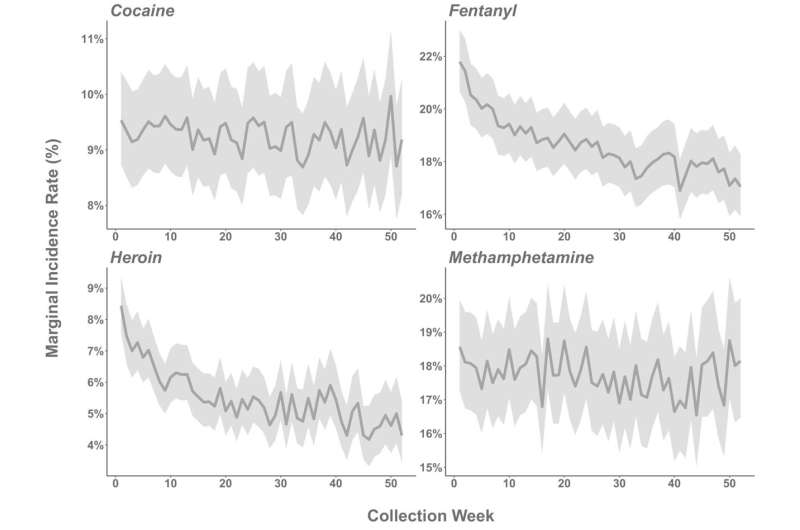
A new study led by a Johns Hopkins Bloomberg School of Public Health researcher found that the percent of patients treated for opioid use disorder with methadone significantly decreased their use of fentanyl during a year of treatment. The percent who tested positive for fentanyl declined on average from 21.8 percent in week one to 17.1 percent in week 52.
The average heroin positivity rate also declined, from 8.4 percent to 4.3 percent. For both heroin and fentanyl, the biggest declines were seen in the first 10 weeks of treatment. The average positivity for methamphetamine and cocaine did not significantly change over the course of 52 weeks of treatment.
For their study, the researchers analyzed urine specimens for illicit substances—including fentanyl, heroin, cocaine, and methamphetamine—among patients receiving treatment at methadone clinics from over 16,000 individuals in 10 states from January 1, 2017, to December 31, 2021. The researchers analyzed urine specimens covering the first 52 observed weeks of an individual’s treatment.
The study was published online May 9 in the journal Addiction.
Methadone is approved by the Food and Drug Administration to treat symptoms of opioid use disorder, including cravings and withdrawal.
“Patients are increasingly testing positive for fentanyl and other illicit drugs at the start of treatment and our study suggests that patients significantly decrease their use of illicit opioids during a year in methadone treatment,” says Brendan Saloner, Ph.D., Bloomberg Associate Professor of American Health in the Department of Health Policy and Management and the study’s lead author.
“At the same time, the prevalence of methamphetamine and cocaine use is on the rise and is not generally decreasing during a year in methadone treatment. These findings will help clinicians identify patients who are at greater risk and can offer additional support.”
The researchers analyzed anonymized urine samples from Millennium Health’s proprietary database. Millennium Health is a drug-testing laboratory that services all 50 states. The study sample drew from patients diagnosed with opioid use disorder who were receiving methadone treatment and who had at least three valid urine specimens in the database.
The researchers used data from Alaska, Arizona, Florida, Illinois, Kentucky, Minnesota, New Mexico, Ohio, Virginia, and Washington. The analysis included 194,333 specimen samples from 16,386 individual patients.
The researchers found that across the five-year study period the first urine specimens collected indicated increasing fentanyl positivity rates in the broader population, from 13.1 percent in 2017 to 53 percent in 2021. The positivity rate for methamphetamine also increased, from 10.6 percent to 27.2 percent, as did cocaine, from 13.8 percent to 19.5 percent.
Additional analyses found that fentanyl positivity was significantly higher for males compared to females. It was also significantly higher in the age group 18–24 than in all other age groups. Fentanyl positivity rates were highest in Ohio, Illinois, Arizona, Kentucky, and Minnesota. Alaska had the highest heroin and methamphetamine positivity.
“Methadone treatment can have tremendous success reducing fentanyl and heroin use in individuals, but this study shows we aren’t addressing the complexity of polysubstance use,” says Saloner. “The findings clearly sound an alarm bell that we need more tools to support other types of substance use.”
Johns Hopkins University Bloomberg School of Public Health

